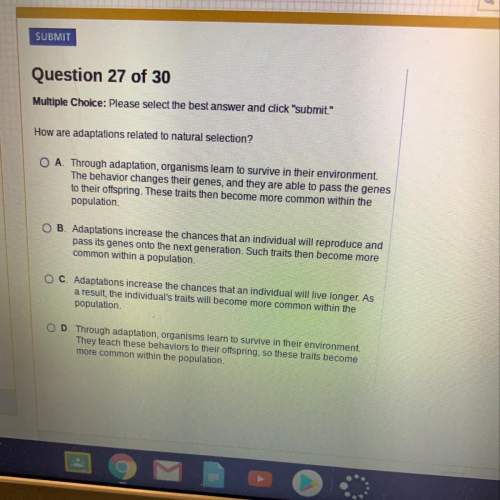
Biology, 25.07.2019 03:00 smithmalyk4
If carbon dioxide is removed from a plants environment, what would happen to the plant's production of high-energy sugars, such as glucose

Answers: 1


Other questions on the subject: Biology

Biology, 21.06.2019 18:00, gora2005
1. the passing of is the basis of heredity. 2. our encode the instructions that define our traits. 3. each of us has thousands of genes, which are made of and reside in our chromosomes. 4. in addition to our genes, the we live in also define our traits. 5. humans have two complete sets of chromosomes. 6. when parents conceive a child, each parent contributes set of chromosomes. 7. every child receives of its chromosomes from the mother and half from the father. 8. this transfer takes place at when the father’s sperm joins the mother’s egg. 9. while most cells in our bodies have two sets of chromosomes, or a total of egg and sperm each have chromosomes. 10. when egg and sperm unite they create a single cell called a 11. each parent contributes complete set of chromosomes to their child. 12. since the parents contribute the chromosomes to each new child, every child inherits a unique set of chromosomes. 13. as a result, every baby will have a combination of traits.
Answers: 1

Biology, 21.06.2019 20:30, chozz2783
Match the descriptions / definitions with the term they best describe 1. three dimensional relationship of the different polypeptide chains in a multisubunit protein or protein complex 2. common folding pattern in proteins in which a linear sequence of amino acids folds into a right-handed coil stabilized by internal hydrogen-bonding between polypeptide backbone atoms. 3. the amino acid sequence of a protein 4. a region on the surface of a protein that can interact with another molecule through noncovalent bonding. 5. three-dimensional arrangement of alpha-helices and beta-sheets within a single polypeptide, typically stabilized by a variety of noncovalent bonds, including ionic and hydrogen bonds, and nonpolar interactions / hydrophobic force. 6. the chain of repeating carbon and nitrogen atoms, linked by peptide bonds, in a protein. 7. common structural motif in proteins in which different sections of the polypeptide chain run alongside each other and are joined together by hydrogen bonding between atoms of the polypeptide backbone. 8. portion of a polypeptide chain that has a discrete tertiary structure of its own and can often fold independently of the rest of the chain 9. regular local folding patterns in a protein, including alpha-helix and beta-sheet a. primary structure b. beta-sheet c. protein d. coiled-coil e. polypeptide backbone f. secondary structure g. side chain h. tertiary structure i. binding site j. alpha-helix k. quaternary structure l. protein domain
Answers: 2

You know the right answer?
If carbon dioxide is removed from a plants environment, what would happen to the plant's production...
Questions in other subjects:

History, 16.07.2019 03:00

History, 16.07.2019 03:00




Spanish, 16.07.2019 03:00

Mathematics, 16.07.2019 03:00






